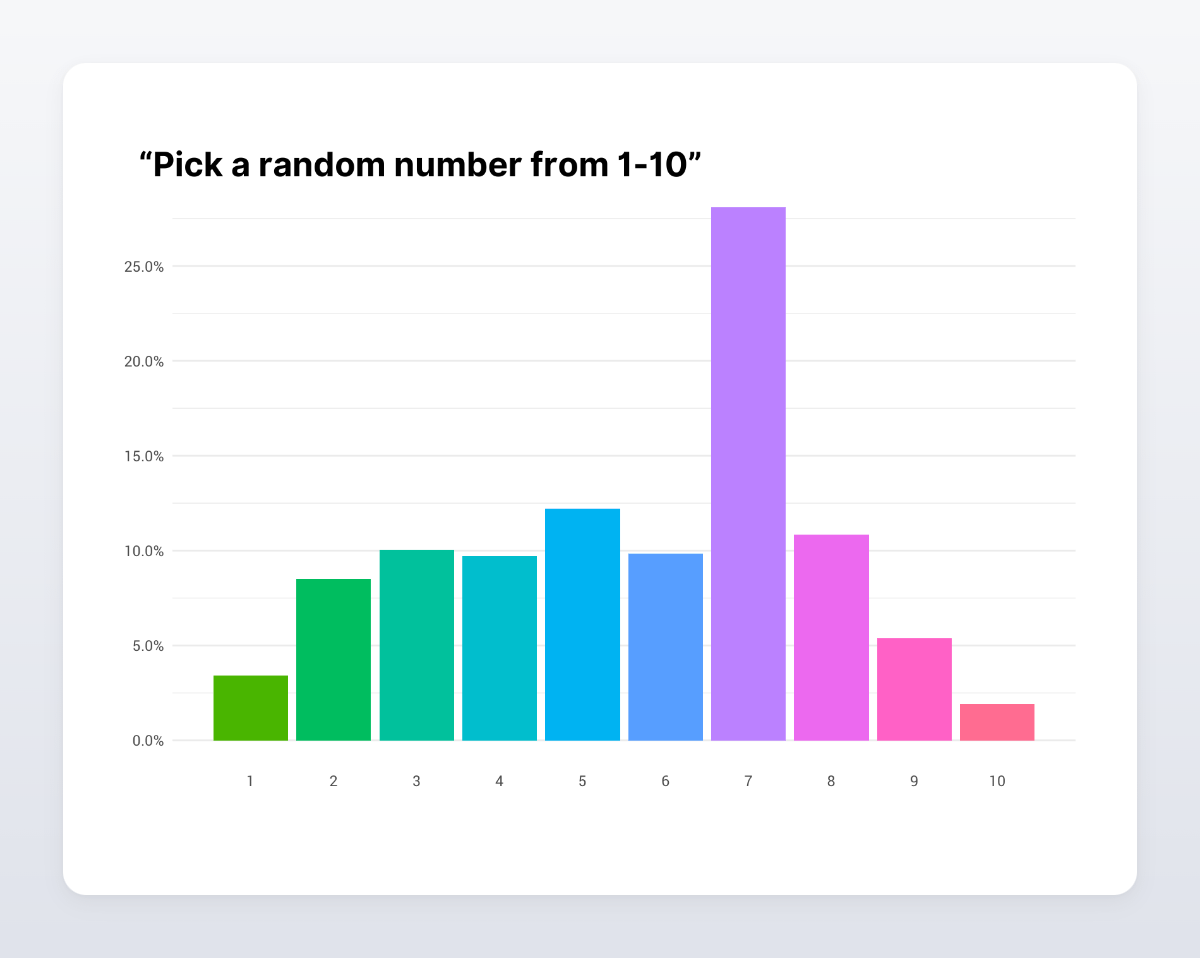Pseudorandom: a fascinating math game for 4+ players [#42]
A fun social experiment game with a very simple premise.
![Pseudorandom: a fascinating math game for 4+ players [#42]](/content/images/size/w1200/2023/09/edge2edge-media-uKlneQRwaxY-unsplash.jpg)
Choose a random number from 1-10.
Done? Let me try to guess which number you chose. Is it 7? If I'm right, you are legally obligated to share this article with one of your friends (just kidding). But surprisingly, most people aren't very random at all when asked to choose a random number. Take a look at this graph:

This graph is based on data from a professor asking over 8500 students to choose a random number from 1-10. A whopping 28% of people chose the number 7, and barely anyone chose 1 or 10. What's going on here? Why is 7 such a popular number? Do people just really like 7?
Now that you've seen this graph, here's another question. You're standing in a room with 9 other people you've never met before. You and the others will all choose a number from 1-10, write it down on a sticky note, and then reveal your numbers at the same time. If you choose a number that no one else chooses, then you win $100.
What number would you choose?
That's the basis of the game Pseudorandom. It's a great social experiment game, and I'd like to share it with you today.
Setup
You'll need the following materials:
- A sticky note and a pencil (with an eraser) for every participant
- One sheet of paper for every two participants (e.g. if you have 50 participants, you only need 25 sheets of paper)
- A Sharpie or marker
- A way to keep score (a whiteboard or computer works)
- Tape (even painter's tape works fine)
If you have N participants, you should have N/2 sheets of paper. Use a Sharpie or large-tip marker to write the integers 1 to N/2 on the sheets of paper (one number per sheet). Then tape those sheets to the floor in a sensible arrangement.
Gameplay
Give each participant a sticky note and a pencil, and ask them to write their name on the sticky note. Let's assume that there are M sheets of paper on the floor, each displaying an integer from 1 to M. Then you can give them the following rules:
- 10 rounds will be played. In each round, a participant has the opportunity to win one (1) point. Whoever has the most points at the end of the 10 rounds wins.
- In each round, each participant will write a new integer from 1–M on their sticky note. (They can erase their previous number.)
- Then, after every participant has written their number, they will stand on the paper containing their number.
- If a participant is standing alone on a sheet of paper, then they win one (1) point, because they picked a number no one else picked.
- If a participant is standing with at least one other person on a sheet of paper, then they do not win a point (because they picked a number that someone else picked).
- Participants are not allowed to 1) look at other people's sticky notes while they are writing on them or 2) stand on a number different from the one they've written down.
- Participants are allowed to 1) talk to fellow participants about the game and 2) team up with other players.
Strategy
There are a few main strategies that emerge in Pseudorandom:
- Dwayne "The Rock" Johnson: Picks the same number every time. Actually a reasonable strategy, because anyone else who picks that number won't get points.
- The Opportunist: Randomly chooses between the numbers that weren't chosen much last round. Not a bad strategy, but there are typically many opportunists in a typical game of Pseudorandom.
- The Real Estate Agent: Randomly chooses between the numbers that were chosen most frequently last round. As they say in the business: location, location, location. If a lot of people like a number, it's worth it to establish a presence there.
- The Mathematician: Uses his phone to randomly choose a number each round. He or she thinks that true randomness is the best way to win a game based mainly on psychology.
Which strategy do you find yourself using?
Conclusion
Pseudorandom is a pretty fun game! I hope you enjoyed my writeup — and perhaps you'll be inspired to host a game of Pseudorandom for your friends.
![I organized a 10-day game of tag with 10 of my friends [#70]](/content/images/size/w960/2025/03/History-Of-Tag.jpg)
![My favorite games this summer [#64]](/content/images/size/w960/2024/07/dennis-cortes-saa-4nYJWns-unsplash-2.jpg)
![I hosted a spectacular 20-acre game of Capture the Flag [#61]](/content/images/size/w960/2024/05/joshua-hoehne-wWkCAnmFF20-unsplash.jpg)
![Mao: a wonderfully infuriating card game [#58]](/content/images/size/w960/2024/03/erik-mclean-p1Xx215ooiM-unsplash.jpg)